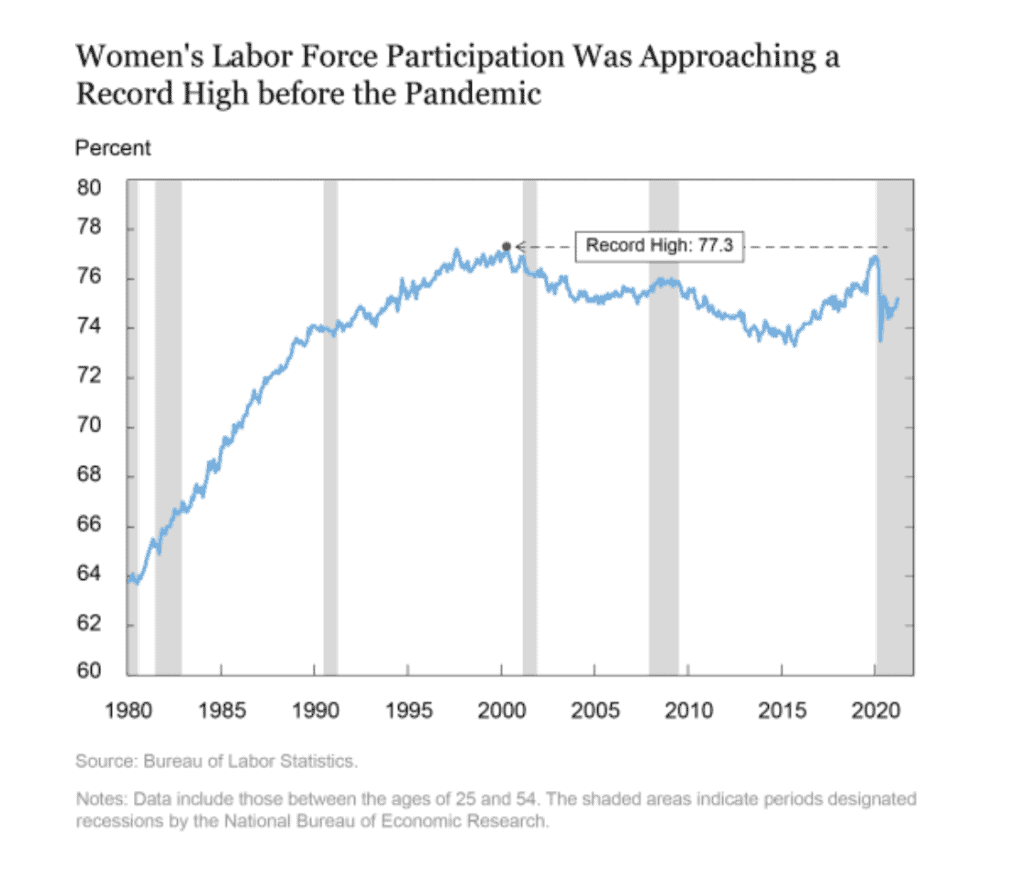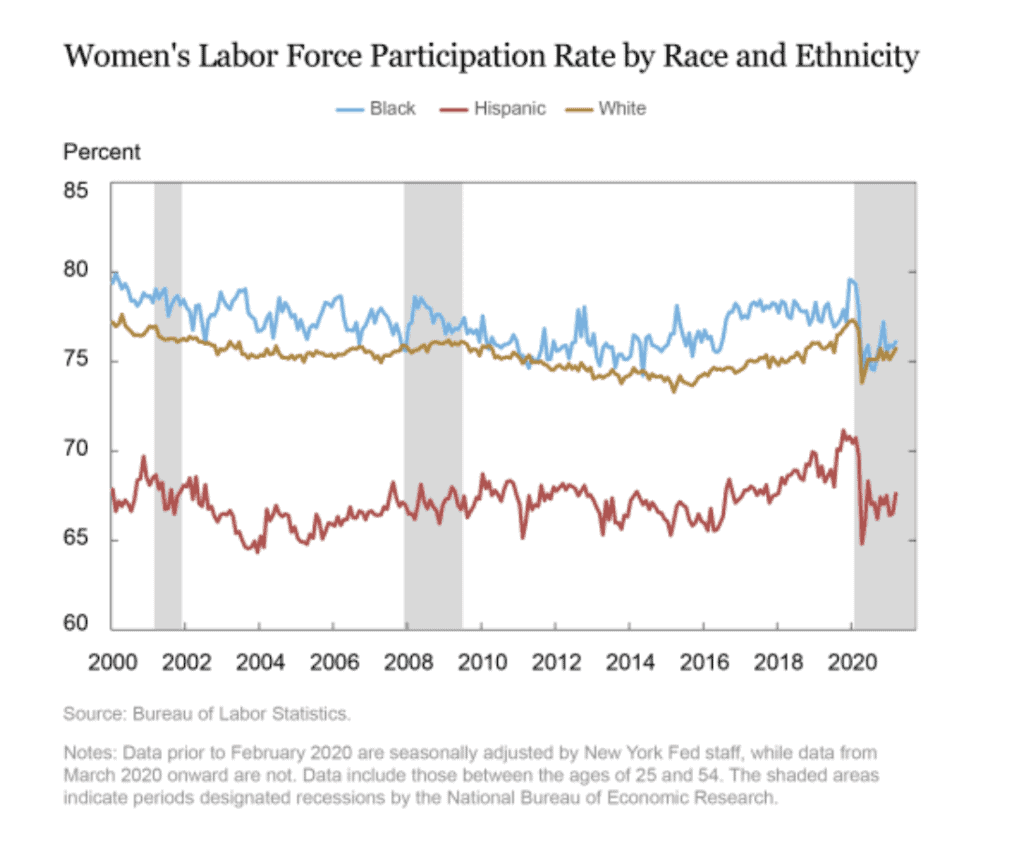Over the past year, we’ve written extensively about the impact of COVID-19 on employment across a variety of population groups, including:
Today we look at an issue that’s been getting increased coverage in recent weeks, and that is the impact the pandemic has had on women’s employment and overall participation in the workforce.
THE UNEMPLOYMENT STORY FOR WOMEN
According to the Bureau of Labor Statistics (BLS), 266,00 jobs were added to the economy in April, 2021, a dramatic decline from March’s level of 770,000. Women accounted for 161,000, or 60.5 percent, of those new jobs. But a separate report by the BLS takes a closer look at working women. You can find a link to the report below, but here are some of the key points covered:
- More than 1 in 12 women, 20+ (5.6 percent), were unemployed as of April, 2021. This rate is 1.8 times higher than prior to the pandemic.
- More than 1 in 12 Black women, 20+, (8.5 percent) are unemployed, also 1.8 times higher than the pre-pandemic levels.
- About 1 in 13 Latinas, 20+ (7.5 percent) are unemployed, 1.5 times more than February, 2020.
- Young women (20-24) have been hit particularly hard by the pandemic, with more than 1 in 12, or 8.5 percent, out of work in April, 2021. Young Latinas and Black women were unemployed at even higher rates, 9.8 percent and 15.1 percent respectively.
- The primary driver of women’s job gains was an overall increase in jobs in the leisure and hospitality sectors.
- Over 15,000 retail jobs were lost in April, with women losing over 26,000 retails jobs, offset by a gain of 11,000 by men.
- As of April, 44.4 percent of all women, 20+, have been out of work six months or longer.
WOMEN’S WORKFORCE PARTICIPATION-AN HISTORICAL PERSPECTIVE
Women’s participation in the labor force had been growing steadily in the closing decades of the 20th century. As we see in the chart below, by 2000, labor force participation had reached 77.3 percent for women of prime working age (25-54)

But in the ensuing 15 years, fueled in great part by the Great Recession, women gave back four points of that workforce participation rate, landing at 73.3 percent by 2015. Women were able to recoup those losses, picking up 3.5 percentage point in labor force participation by 2020, a net increase that was about three times the level experienced by men during the same period.
It’s also worth noting that the expanding economy created tremendous demand for labor, which resulted in real wage increases for both men and women, at record levels. See the chart below:

THEN, THE PANDEMIC HIT!
Most of the gains enjoyed by women were wiped out when the COVID-19 pandemic essentially shut down much of the economy. We saw the unemployment story outlined above. But, perhaps more importantly, women’s labor force participation dropped nearly three percentage points in March and April, 2020, alone (NOTE: to be considered “unemployed” you must be actively looking for a job; otherwise, you are considered out of the workforce). This dramatic decline, of course, was closely linked to the fact that women took on a greater degree of childcare responsibilities as schools and daycare centers shut down. Things have improved with the recent economic recovery, but female workforce participation.
RACE, ETHNICITY AND WORKFORCE PANDEMIC, BEFORE AND AFTER THE PANDEMIC
Historical workforce participation trends for women of color paralleled those of white women, but at much different rates. In particular, Black women experienced a five-point decline in workforce participation between 2000-2015, nearly a point-and-a-half difference compared to white working women.
Leading into 2020, both black and white women recovered nearly all of the ground that was lost between 2000-2015, with both groups approaching record levels of workforce participation. Hispanic women, who historically have had lower workforce participation, saw near record participation heading into 2020.
However, as we see in the chart below, the pandemic had a much more deleterious impact on woman of color:

Black and Hispanic women saw declines in workforce participation of 5.2 and 5.9 percentage points respectively-compared to a 3.3. percentage point decline for white women. These differences were tied to several variables:
- Higher rates of COVID infection within communities of color.
- Higher rates of childcare requirements due to school closings (i.e. more single-parent homes).
- Fewer opportunities for telecommuting work.
As more people are vaccinated and certain sectors of economy begin to rebound (e.g., leisure/hospitality, retail, service), we can expect to see both the employment and workforce participation story for all women begin to improve. That said, it will still be a long climb back for women, as summarized in the aforementioned BLS report:
“Women would need more than two years (about 28 months) of job gains at April’s rate to recover the 4.5 million jobs lost since the start of the pandemic.”
SOURCE
https://nwlc.org/wp-content/uploads/2021/05/April-Jobs-Day-Final-2.pdf
To learn more about Recovery Decision Science contact:
Kacey Rask : Vice-President, Portfolio Servicing
[email protected] / 513.489.8877, ext. 261
Error: Contact form not found.
